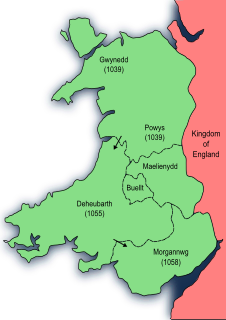Rhydderch ap Iestyn (died 1033) was king of Gwent and Morgannwg in south Wales and later took over the kingdom of Deheubarth and controlled Powys.

Gwent was a medieval Welsh kingdom, lying between the Rivers Wye and Usk. It existed from the end of Roman rule in Britain in about the 5th century until the Norman conquest of England in the 11th century. Along with its neighbour Glywyssing, it seems to have had a great deal of cultural continuity with the earlier Silures, keeping their own courts and diocese separate from the rest of Wales until their conquest by Gruffydd ap Llywelyn. Although it recovered its independence after his death in 1063, Gwent was the first of the Welsh kingdoms to be overrun following the Norman conquest.

Wales is a country that is part of the United Kingdom and the island of Great Britain. It is bordered by England to the east, the Irish Sea to the north and west, and the Bristol Channel to the south. It had a population in 2011 of 3,063,456 and has a total area of 20,779 km2 (8,023 sq mi). Wales has over 1,680 miles (2,700 km) of coastline and is largely mountainous, with its higher peaks in the north and central areas, including Snowdon, its highest summit. The country lies within the north temperate zone and has a changeable, maritime climate.

Deheubarth was a regional name for the realms of south Wales, particularly as opposed to Gwynedd. It is now used as a shorthand for the various realms united under the House of Dinefwr, but that Deheubarth itself was not considered a proper kingdom on the model of Gwynedd, Powys, or Dyfed is shown by its rendering in Latin as dextralis pars or as Britonnes dexterales and not as a named land. In the oldest British writers, Deheubarth was used for all of modern Wales to distinguish it from Hen Ogledd, the northern lands whence Cunedda and the Cymry originated.
Comparatively little has been recorded about Rhydderch ab Iestyn in the annals. He appears to have originally been ruler of Gwent and Morgannwg, where his son later continued to have his power base. When Llywelyn ap Seisyll, king of Gwynedd and Deheubarth died unexpectedly in 1023, Rhydderch was able to seize Deheubarth, apparently by force of arms. In 1033 Rhydderch is recorded by Brut y Tywysogion as having been slain by the Irish, but with no explanation of the circumstances.
Llywelyn ap Seissyll was an 11th-century King of Gwynedd, Powys and Deheubarth.

The Kingdom of Gwynedd was a Roman Empire successor state that emerged in sub-Roman Britain in the 5th century during the Anglo-Saxon settlement of Britain.

Brut y Tywysogion, also known as Brut y Tywysogyon, is one of the most important primary sources for Welsh history. It is an annalistic chronicle that serves as a continuation of Geoffrey of Monmouth’s Historia Regum Britanniae. Brut y Tywysogion has survived as several Welsh translations of an original Latin version, which has not itself survived. The most important versions are the one in Robert Vaughan's Peniarth MS. 20 and the slightly less complete one in the Red Book of Hergest. The version entitled Brenhinoedd y Saeson combines material from the Welsh annals with material from an English source.
The kingdom of Deheubarth returned to the original dynasty in the form of Hywel ab Edwin and his brother Maredudd. A battle between Hywel and his brother and the sons of Rhydderch is recorded the following year. In 1045 Rhydderch's son, Gruffydd ap Rhydderch was able to seize Deheubarth from Gruffydd ap Llywelyn and held it for ten years until Gruffydd regained it.
Hywel ap Edwin was king of Deheubarth in south Wales from 1033 to 1043.
Gruffydd ap Rhydderch was a king of Gwent and part of the kingdom of Morgannwg in south Wales and later king of Deheubarth.

Gruffydd ap Llywelyn was the King of Wales from 1055 to 1063. He was the son of King Llywelyn ap Seisyll and Angharad, daughter of Maredudd ab Owain. He was the great-great-grandson of Hywel Dda.
Rhydderch had at least three sons, they were as follows:
- Gruffydd ap Rhydderch (died 1055), King of Morgannwg and Deheubarth, killed in battle against Gruffydd ap Llywelyn.
- Caradog ap Rhydderch (died 1035), killed by the "Saxons".
- Rhys ap Rhydderch (died 5 January 1053), put to death by order of King Edward the Confessor.
Rhys ap Rhydderch was the brother of Gruffydd ap Rhydderch, king of Deheubarth from 1044 to 1055. Both were the sons of Rhydderch ab Iestyn, who had been able to take over the Welsh kingdom of Deheubarth from 1023 to 1033.

Edward the Confessor, also known as Saint Edward the Confessor, was among the last Anglo-Saxon kings of England. Usually considered the last king of the House of Wessex, he ruled from 1042 to 1066.


